Around the World
March/April 2022
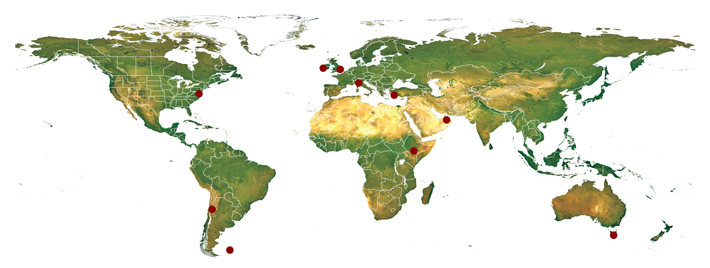

-
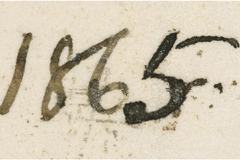 WASHINGTON, D.C.: The National Archives holds a famous letter dated April 14, 1865, in which Abraham Lincoln pardons Private Patrick Murphy on a charge of desertion. The document is noteworthy because Lincoln was assassinated later that very day, suggesting that one of his last official deeds was saving a condemned man from death. New examination of the letter has confirmed that the number 4 in the year was erased and replaced with a 5. The letter was actually written in 1864, a year before Lincoln’s death.
WASHINGTON, D.C.: The National Archives holds a famous letter dated April 14, 1865, in which Abraham Lincoln pardons Private Patrick Murphy on a charge of desertion. The document is noteworthy because Lincoln was assassinated later that very day, suggesting that one of his last official deeds was saving a condemned man from death. New examination of the letter has confirmed that the number 4 in the year was erased and replaced with a 5. The letter was actually written in 1864, a year before Lincoln’s death. -
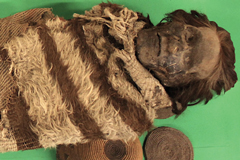 ARGENTINA: Archaeologists are able to extract DNA from human bones and teeth, but the process is destructive. A new, less-invasive method involves recovering genetic material from the scalps of people who suffered from head lice. DNA sequencing was carried out on 2,000-year-old mummies entombed in the Calingasta Caves using skin cells trapped in the glue-like substance excreted by lice on their hair. The results revealed that some of the local population migrated to the Andes from the Amazon rain forest region.
ARGENTINA: Archaeologists are able to extract DNA from human bones and teeth, but the process is destructive. A new, less-invasive method involves recovering genetic material from the scalps of people who suffered from head lice. DNA sequencing was carried out on 2,000-year-old mummies entombed in the Calingasta Caves using skin cells trapped in the glue-like substance excreted by lice on their hair. The results revealed that some of the local population migrated to the Andes from the Amazon rain forest region. -
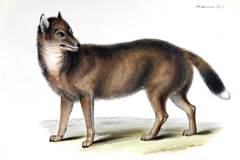 FALKLAND ISLANDS: Scholars including Charles Darwin have long debated how the archipelago’s only native terrestrial mammal—the rather tame and now-extinct Falkland Islands wolf—got there. They rejected human introduction because the animal, also known as a warrah, was already present when Europeans landed on the islands’ uninhabited shores in 1690. However, new evidence suggests that the Indigenous South American Yaghan people periodically visited the isles centuries earlier. It is possible these early seafarers, who are known for their close human-canid relationships, brought the first warrahs with them.
FALKLAND ISLANDS: Scholars including Charles Darwin have long debated how the archipelago’s only native terrestrial mammal—the rather tame and now-extinct Falkland Islands wolf—got there. They rejected human introduction because the animal, also known as a warrah, was already present when Europeans landed on the islands’ uninhabited shores in 1690. However, new evidence suggests that the Indigenous South American Yaghan people periodically visited the isles centuries earlier. It is possible these early seafarers, who are known for their close human-canid relationships, brought the first warrahs with them. -
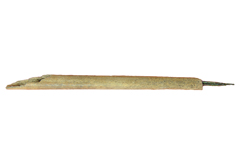 IRELAND: A pen discovered at the 11th-century ringfort of Caherconnell Cashel is believed to be the oldest such object ever found in Ireland. It was made from a hollowed-out bone and has a copper-alloy nib, which would have been dipped into an inkwell. Given that religious settings were more closely associated with literacy at the time, it is surprising that this writing implement was discovered in a secular setting.
IRELAND: A pen discovered at the 11th-century ringfort of Caherconnell Cashel is believed to be the oldest such object ever found in Ireland. It was made from a hollowed-out bone and has a copper-alloy nib, which would have been dipped into an inkwell. Given that religious settings were more closely associated with literacy at the time, it is surprising that this writing implement was discovered in a secular setting. -
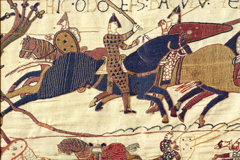 ENGLAND: Size, it seems, doesn’t always matter. Despite the popular portrayal of medieval warhorses as massive, powerful beasts that tore across battlefields, they were actually much smaller than today’s horses, and even than horses from the Roman era or Iron Age. A study of 2,000 horse bones from 171 different sites ranging from the 4th through 17th centuries A.D. indicates the animals were in fact pony-sized. It’s possible that traits such as speed, maneuverability, and temperament were more important factors than size during the breeding process.
ENGLAND: Size, it seems, doesn’t always matter. Despite the popular portrayal of medieval warhorses as massive, powerful beasts that tore across battlefields, they were actually much smaller than today’s horses, and even than horses from the Roman era or Iron Age. A study of 2,000 horse bones from 171 different sites ranging from the 4th through 17th centuries A.D. indicates the animals were in fact pony-sized. It’s possible that traits such as speed, maneuverability, and temperament were more important factors than size during the breeding process. -
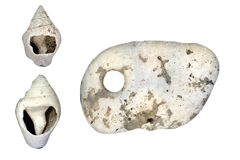 ITALY: A baby girl who died 10,000 years ago was very young when she perished, but she was buried with great care. Dental analysis suggests the girl only lived about 40 or 50 days before being laid to rest in a shallow pit in Arma Veirana Cave in Liguria. She was wrapped in a garment adorned with more than 60 shell beads and pendants. This rare Mesolithic female infant burial is believed to be the earliest of its kind found in Europe.
ITALY: A baby girl who died 10,000 years ago was very young when she perished, but she was buried with great care. Dental analysis suggests the girl only lived about 40 or 50 days before being laid to rest in a shallow pit in Arma Veirana Cave in Liguria. She was wrapped in a garment adorned with more than 60 shell beads and pendants. This rare Mesolithic female infant burial is believed to be the earliest of its kind found in Europe. -
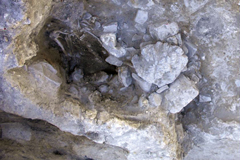 TURKEY: A teenager and a dog buried in destruction layers at the settlement of Çesme-Baglararası are believed to be the first victims of the eruption of Thera, which occurred 3,600 years ago, ever discovered. The catastrophic explosion on the present-day island of Santorini, 140 miles away, triggered tsunamis that destroyed the coastal Bronze Age settlement. Evidence shows that survivors attempted to dig through the rubble to rescue those trapped—they only missed locating the young man and canine by about 3 feet.
TURKEY: A teenager and a dog buried in destruction layers at the settlement of Çesme-Baglararası are believed to be the first victims of the eruption of Thera, which occurred 3,600 years ago, ever discovered. The catastrophic explosion on the present-day island of Santorini, 140 miles away, triggered tsunamis that destroyed the coastal Bronze Age settlement. Evidence shows that survivors attempted to dig through the rubble to rescue those trapped—they only missed locating the young man and canine by about 3 feet. -
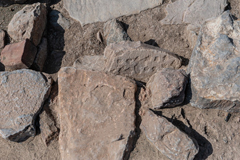 OMAN: An ancient game board was unearthed in the ruins of a 4,000-year-old site near the village of Ayn Bani Saidah in the Qumayrah Valley. The rectangular stone slab is marked with spatial divisions and small depressions or cup holes and resembles other games known from sites across the ancient Near East and India. Evidence of copper smelting and the settlement’s strategic location along major trade routes suggest that it may have been an important commercial center during the Umm an-Nar period.
OMAN: An ancient game board was unearthed in the ruins of a 4,000-year-old site near the village of Ayn Bani Saidah in the Qumayrah Valley. The rectangular stone slab is marked with spatial divisions and small depressions or cup holes and resembles other games known from sites across the ancient Near East and India. Evidence of copper smelting and the settlement’s strategic location along major trade routes suggest that it may have been an important commercial center during the Umm an-Nar period. -
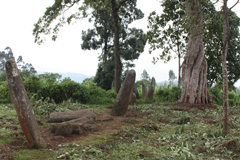 ETHIOPIA: The Gedeo Zone in southern Ethiopia is home to Africa’s largest concentration of megalithic stone stelas. Some of the 10,000 carved monuments reach heights of 20 feet. New dating of the monoliths found at the site of Sakaro Sodo indicates that they were created around the 1st century A.D., more than 1,000 years earlier than previously thought. Experts believe the stelas may have served as burial markers or to commemorate the transfer of power from one generation to the next.
ETHIOPIA: The Gedeo Zone in southern Ethiopia is home to Africa’s largest concentration of megalithic stone stelas. Some of the 10,000 carved monuments reach heights of 20 feet. New dating of the monoliths found at the site of Sakaro Sodo indicates that they were created around the 1st century A.D., more than 1,000 years earlier than previously thought. Experts believe the stelas may have served as burial markers or to commemorate the transfer of power from one generation to the next. -
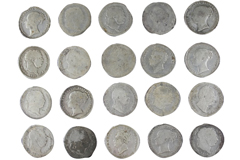 TASMANIA: In the 1850s, a convict serving time at the Port Arthur penal colony surreptitiously buried a stash of silver shillings in a clay floor. He was never able to retrieve his treasure, which was recently found during excavations in one of the prison complex’s metal-casting workshops. At the time, prisoners were strictly prohibited from carrying money, but one crafty inmate seems to have managed to dispossess an unsuspecting guard of his cash, which was equal to about a week’s pay.
TASMANIA: In the 1850s, a convict serving time at the Port Arthur penal colony surreptitiously buried a stash of silver shillings in a clay floor. He was never able to retrieve his treasure, which was recently found during excavations in one of the prison complex’s metal-casting workshops. At the time, prisoners were strictly prohibited from carrying money, but one crafty inmate seems to have managed to dispossess an unsuspecting guard of his cash, which was equal to about a week’s pay.
Advertisement
IN THIS ISSUE
Features
A Monumental Imperial Biography
The Last King of Babylon
Paradise Lost
Exploring Notre Dame's Hidden Past
Letter from Doggerland
Digs & Discoveries
Poetic License
Gone Fishing
A Shining Example
Oliveopolis
Kublai Khan's Sinking Ambitions
The Treasurer's Tomb
Tudor Travelers
Who Drank From Nestor's Cup?
Reflecting the Past
Murder Will Out
Off the Grid
Around the World
Medieval war ponies, an ancient Arabian board game, the Falkland Islands wolf, and the dead of Santorini
Artifact
Connected by craft in the deep past
Advertisement

Recent Issues
-
 May/June 2024
May/June 2024
-
 March/April 2024
March/April 2024
-
 January/February 2024
January/February 2024
-
 November/December 2023
November/December 2023
-
 September/October 2023
September/October 2023
-
 July/August 2023
July/August 2023
-
 May/June 2023
May/June 2023
-
 March/April 2023
March/April 2023
-
 January/February 2023
January/February 2023
-
 November/December 2022
November/December 2022
-
 September/October 2022
September/October 2022
-
 July/August 2022
July/August 2022
-
 May/June 2022
May/June 2022
-
 March/April 2022
March/April 2022
-
 January/February 2022
January/February 2022
-
 November/December 2021
November/December 2021
-
 September/October 2021
September/October 2021
-
 July/August 2021
July/August 2021
-
 May/June 2021
May/June 2021
-
 March/April 2021
March/April 2021
-
 January/February 2021
January/February 2021
-
 November/December 2020
November/December 2020
-
 September/October 2020
September/October 2020
-
 July/August 2020
July/August 2020
-
 May/June 2020
May/June 2020
-
 March/April 2020
March/April 2020
-
 January/February 2020
January/February 2020
-
 November/December 2019
November/December 2019
-
 September/October 2019
September/October 2019
-
 July/August 2019
July/August 2019
-
 May/June 2019
May/June 2019
-
 March/April 2019
March/April 2019
-
 January/February 2019
January/February 2019
-
 November/December 2018
November/December 2018
-
 September/October 2018
September/October 2018
-
 July/August 2018
July/August 2018
-
 May/June 2018
May/June 2018
-
 March/April 2018
March/April 2018
-
 January/February 2018
January/February 2018
-
 November/December 2017
November/December 2017
-
 September/October 2017
September/October 2017
-
 July/August 2017
July/August 2017
-
 May/June 2017
May/June 2017
-
 March/April 2017
March/April 2017
-
 January/February 2017
January/February 2017
-
 November/December 2016
November/December 2016
-
 September/October 2016
September/October 2016
-
 July/August 2016
July/August 2016
-
 May/June 2016
May/June 2016
-
 March/April 2016
March/April 2016
-
 January/February 2016
January/February 2016
-
 November/December 2015
November/December 2015
-
 September/October 2015
September/October 2015
-
 July/August 2015
July/August 2015
-
 May/June 2015
May/June 2015
-
 March/April 2015
March/April 2015
-
 January/February 2015
January/February 2015
-
 November/December 2014
November/December 2014
-
 September/October 2014
September/October 2014
-
 July/August 2014
July/August 2014
-
 May/June 2014
May/June 2014
-
 March/April 2014
March/April 2014
-
 January/February 2014
January/February 2014
-
 November/December 2013
November/December 2013
-
 September/October 2013
September/October 2013
-
 July/August 2013
July/August 2013
-
 May/June 2013
May/June 2013
-
 March/April 2013
March/April 2013
-
 January/February 2013
January/February 2013
-
 November/December 2012
November/December 2012
-
 Sep/Oct 2012
Sep/Oct 2012
-
 September/October 2012
September/October 2012
-
 July/August 2012
July/August 2012
-
 May/June 2012
May/June 2012
-
 March/April 2012
March/April 2012
-
 January/February 2012
January/February 2012
-
 November/December 2011
November/December 2011
-
 September/October 2011
September/October 2011
-
 July/August 2011
July/August 2011
-
 May/June 2011
May/June 2011
-
 March/April 2011
March/April 2011
-
 January/February 2011
January/February 2011
Advertisement






